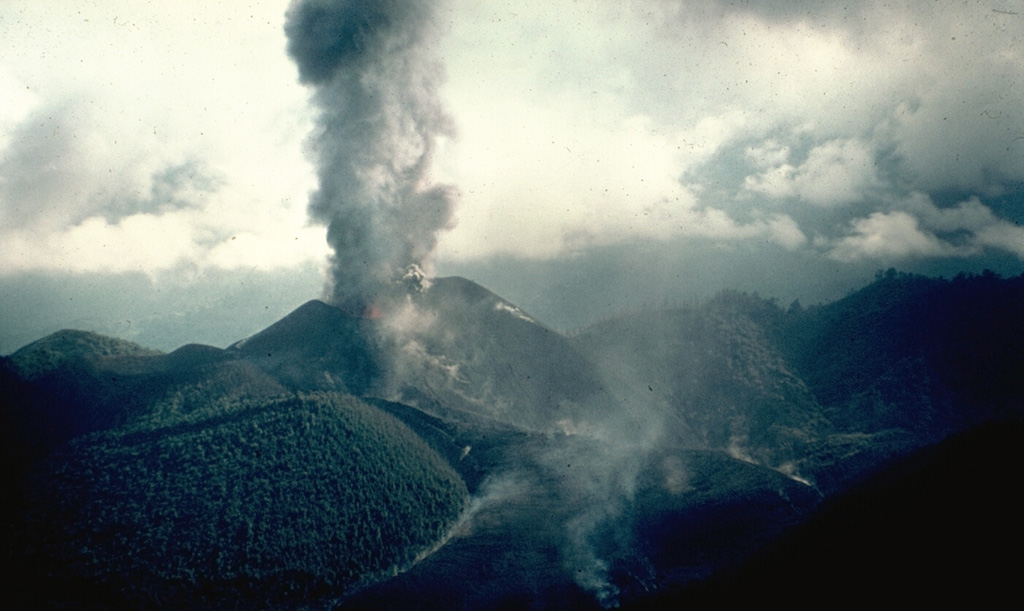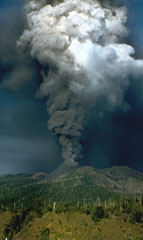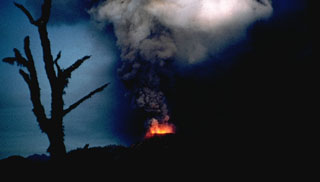

Fumarolic activity continues
Fumarolic activity has persisted from Mirador crater since its ash and lava eruption of April-May. A dense, yellowish-white steam cloud emerged from Mirador's summit during a visit by L. López, A. Lahsen, and H. Moreno on 1 November. The surfaces of two lava flows extruded on 12 May were covered by a yellowish salt deposit composed mainly of iron chlorides.
Information Contacts: H. Moreno R., Univ. de Chile, Santiago.
The Global Volcanism Program has no Weekly Reports available for Carrán-Los Venados.
Reports are organized chronologically and indexed below by Month/Year (Publication Volume:Number), and include a one-line summary. Click on the index link or scroll down to read the reports.
Voluminous ash emission and lava flow
An eruption of pyroclastics from Mirador, one of the craters in the Carrán volcanic group (figure 1), began at 0200 on [14] April, preceded by local seismicity. The column of gas and ash reached altitudes of 3-4 km, and was accompanied by gas explosions in the mouth of the crater. After about 40 hours, lava began to flow SSW, traveling about 500 m by the 17th. Voluminous ash emission persisted, with explosions occurring every 5 minutes, and local seismicity was continuous. The activity continued to increase through 18 April. Ash covered agricultural land near the volcano. No one has been killed, but authorities have evacuated 125 people from the area.
The most recent previous activity in the area was an explosive eruption in 1955, in which two people were killed. At least two of the volcanic features in the Carrán group are maars.
Reference. López, L. and Moreno, H., 1981, Erupción de 1979 del volcán Mirador, Andes del Sur, 40°21'S: características geoquímicas de las lavas y xenolitos graníticos: Revista Geológica de Chile, no. 13-14, p. 17-33.
Information Contacts: O. González-Ferrán, Univ. de Chile, Santiago.
Eruption resumes
Local authorities report that the eruption of Mirador crater resumed on 12 May (figure 15-17) [see also 4:7] and was continuing 24 hours later. Incandescent material rose 30 m above the vent and a series of low-intensity tremors occurred. Subterranean rumbling, followed by several hours of earthquakes, was reported from Río Buenos, about 40 km away. Carrán's vigorous mid-April eruption had stopped after a few days.
Information Contacts: Latin Radio Network, Buenos Aires, Argentina.
Eruption ends
The eruption of Mirador began violently on [14] April, but activity declined quickly to more moderate levels. Explosions and accompanying seismicity then gradually decreased in frequency and intensity until the eruption ended on 25 May. Ash deposits were 2-3 cm thick at the base of Mirador and ash fell as much as 20 km away. A small amount of lava (andesitic basalt in hand specimen) flowed NE and SE.
Further References. Moreno, H., 1980, La erupción del volcán Mirador en Abril-Mayo de 1979, lago Ranco-Rininahue, Andes del Sur: Comunicaciones, Universidad de Chile, no. 28, p. 1-23.
Information Contacts: O. González-Ferrán, Univ. de Chile, Santiago.
Fumarolic activity continues
Fumarolic activity has persisted from Mirador crater since its ash and lava eruption of April-May. A dense, yellowish-white steam cloud emerged from Mirador's summit during a visit by L. López, A. Lahsen, and H. Moreno on 1 November. The surfaces of two lava flows extruded on 12 May were covered by a yellowish salt deposit composed mainly of iron chlorides.
Information Contacts: H. Moreno R., Univ. de Chile, Santiago.
This compilation of synonyms and subsidiary features may not be comprehensive. Features are organized into four major categories: Cones, Craters, Domes, and Thermal Features. Synonyms of features appear indented below the primary name. In some cases additional feature type, elevation, or location details are provided.
Synonyms |
||||
| Nilahue | ||||
Cones |
||||
| Feature Name | Feature Type | Elevation | Latitude | Longitude |
| Bellavista, Cerro | Pyroclastic cone | 646 m | 40° 21' 15" S | 72° 1' 30" W |
| Chancho, Volcán | Pyroclastic cone | 672 m | 40° 21' 30" S | 72° 2' 30" W |
| Chascon Norte, Cerro | Pyroclastic cone | 723 m | 40° 20' 49" S | 72° 1' 50" W |
| Chascon Sur, Cerro | Pyroclastic cone | 705 m | 40° 21' 5" S | 72° 1' 30" W |
|
Guindos, Los
Carrán, Cerro |
Stratovolcano | 1114 m | 40° 18' 29" S | 72° 4' 0" W |
| Lumanto, Cerro | Pyroclastic cone | 675 m | 40° 20' 50" S | 72° 2' 45" W |
| Media Luna, Volcán | Cone | 759 m | 40° 23' 20" S | 72° 1' 0" W |
| Mirador | Pyroclastic cone | 700 m | 40° 21' 30" S | 72° 3' 30" W |
| Negro, Cerro | Pyroclastic cone | 1055 m | 40° 22' 30" S | 72° 8' 35" W |
| Pichi, Volcán | Pyroclastic cone | 370 m | 40° 22' 30" S | 72° 12' 0" W |
| Providencia, Volcán | Pyroclastic cone | 296 m | 40° 20' 20" S | 72° 0' 30" W |
| Puchura, Volcán | Pyroclastic cone | 713 m | 40° 21' 30" S | 72° 7' 30" W |
| Quirrasco, Volcán | Pyroclastic cone | 478 m | 40° 21' 0" S | 72° 9' 0" W |
| Taza, Cerro la | Pyroclastic cone | 402 m | 40° 20' 45" S | 72° 0' 30" W |
| Yolye, Volcán | Pyroclastic cone | 515 m | 40° 20' 10" S | 72° 4' 0" W |
Craters |
||||
| Feature Name | Feature Type | Elevation | Latitude | Longitude |
|
Carrán
Pillanilahue |
Maar | 276 m | 40° 21' 45" S | 72° 4' 15" W |
| Negro, Laguna | Maar | 300 m | 40° 22' 0" S | 72° 4' 0" W |
| Pocura, Laguna | Maar | 486 m | 40° 20' 45" S | 72° 5' 45" W |
|
Riñinahue
Corral Quemado Quemado |
Maar | 347 m | 40° 22' 15" S | 72° 4' 45" W |
| Venados, Los | Fissure vent | 709 m | 40° 23' 50" S | 72° 9' 0" W |
|
|
||||||||||||||||||||||||||
There is data available for 3 confirmed Holocene eruptive periods.
1979 Apr 14 - 1979 May 20 Confirmed Eruption VEI: 2
| Episode 1 | Eruption | Mirador | |||||||||||||||||||||||||||||||||||||||||||||||||||||||||||
|---|---|---|---|---|---|---|---|---|---|---|---|---|---|---|---|---|---|---|---|---|---|---|---|---|---|---|---|---|---|---|---|---|---|---|---|---|---|---|---|---|---|---|---|---|---|---|---|---|---|---|---|---|---|---|---|---|---|---|---|---|
| 1979 Apr 14 - 1979 May 20 | Evidence from Observations: Reported | |||||||||||||||||||||||||||||||||||||||||||||||||||||||||||
|
List of 10 Events for Episode 1 at Mirador
| ||||||||||||||||||||||||||||||||||||||||||||||||||||||||||||
1955 Jul 27 - 1955 Nov 12 Confirmed Eruption VEI: 4
| Episode 1 | Eruption | Carrán Maar | ||||||||||||||||||||||||||||||||||||||||||||||||||||||||||||||||||||||||||
|---|---|---|---|---|---|---|---|---|---|---|---|---|---|---|---|---|---|---|---|---|---|---|---|---|---|---|---|---|---|---|---|---|---|---|---|---|---|---|---|---|---|---|---|---|---|---|---|---|---|---|---|---|---|---|---|---|---|---|---|---|---|---|---|---|---|---|---|---|---|---|---|---|---|---|---|
| 1955 Jul 27 - 1955 Nov 12 | Evidence from Observations: Reported | ||||||||||||||||||||||||||||||||||||||||||||||||||||||||||||||||||||||||||
|
List of 13 Events for Episode 1 at Carrán Maar
| |||||||||||||||||||||||||||||||||||||||||||||||||||||||||||||||||||||||||||
1907 Apr 9 - 1908 Feb (in or after) Confirmed Eruption VEI: 3
| Episode 1 | Eruption | Riñinahue Maar | |||||||||||||||||||||||||||||||||||||||||||||||||||||||||||
|---|---|---|---|---|---|---|---|---|---|---|---|---|---|---|---|---|---|---|---|---|---|---|---|---|---|---|---|---|---|---|---|---|---|---|---|---|---|---|---|---|---|---|---|---|---|---|---|---|---|---|---|---|---|---|---|---|---|---|---|---|
| 1907 Apr 9 - 1908 Feb (in or after) | Evidence from Observations: Reported | |||||||||||||||||||||||||||||||||||||||||||||||||||||||||||
|
List of 10 Events for Episode 1 at Riñinahue Maar
| ||||||||||||||||||||||||||||||||||||||||||||||||||||||||||||
There is no Deformation History data available for Carrán-Los Venados.
There is no Emissions History data available for Carrán-Los Venados.
 The third historical eruption of the Carran-Los Venados volcanic field began with strombolian explosions at 0100 hrs on April 14, 1979. A 3-4 km high eruption column produced ashfall that covered agricultural lands near the volcano. A new pyroclastic cone rose at the site of a prehistorical cone. Lava flowed 1 km to the SSW from the new breached crater in April. Beginning on May 12, lava flows traveled short distances from the breached crater to the SE and from the crater rim to the NE base of the cone. The eruption ended on May 20.
The third historical eruption of the Carran-Los Venados volcanic field began with strombolian explosions at 0100 hrs on April 14, 1979. A 3-4 km high eruption column produced ashfall that covered agricultural lands near the volcano. A new pyroclastic cone rose at the site of a prehistorical cone. Lava flowed 1 km to the SSW from the new breached crater in April. Beginning on May 12, lava flows traveled short distances from the breached crater to the SE and from the crater rim to the NE base of the cone. The eruption ended on May 20. An ash plume rises from Volcan Mirador, a pyroclastic cone that formed during an eruption in 1979. The Carran-Los Venados volcano group includes about 50 scoria cones, maars, and a small stratovolcano that are broadly aligned along a 17-km-long ENE-WSW trend. The volcano group occupies a low-lying area north of the Cordón Caulle-Pueyhue volcanic chain. In addition to the 1979 Mirador scoria cone, two maars, Rininahue and Carran, were formed during eruptions in the 20th century.
An ash plume rises from Volcan Mirador, a pyroclastic cone that formed during an eruption in 1979. The Carran-Los Venados volcano group includes about 50 scoria cones, maars, and a small stratovolcano that are broadly aligned along a 17-km-long ENE-WSW trend. The volcano group occupies a low-lying area north of the Cordón Caulle-Pueyhue volcanic chain. In addition to the 1979 Mirador scoria cone, two maars, Rininahue and Carran, were formed during eruptions in the 20th century.  Incandescent ejecta are visible at the base of a strombolian eruption column from Volcán Mirador in 1979. The eruption began on April 14 at the site of a prehistorical cinder cone. Almost constant explosive activity produced a new 200-m-high cinder cone, Volcán Mirador, and deposited ash over agricultural areas, prompting the evacuation of 125 people living nearby. Short lava flows traveled to the SE and NE in April and May before the eruption ended on May 20.
Incandescent ejecta are visible at the base of a strombolian eruption column from Volcán Mirador in 1979. The eruption began on April 14 at the site of a prehistorical cinder cone. Almost constant explosive activity produced a new 200-m-high cinder cone, Volcán Mirador, and deposited ash over agricultural areas, prompting the evacuation of 125 people living nearby. Short lava flows traveled to the SE and NE in April and May before the eruption ended on May 20. Maps are not currently available due to technical issues.
There are no samples for Carrán-Los Venados in the Smithsonian's NMNH Department of Mineral Sciences Rock and Ore collection.
| Copernicus Browser | The Copernicus Browser replaced the Sentinel Hub Playground browser in 2023, to provide access to Earth observation archives from the Copernicus Data Space Ecosystem, the main distribution platform for data from the EU Copernicus missions. |
| MIROVA | Middle InfraRed Observation of Volcanic Activity (MIROVA) is a near real time volcanic hot-spot detection system based on the analysis of MODIS (Moderate Resolution Imaging Spectroradiometer) data. In particular, MIROVA uses the Middle InfraRed Radiation (MIR), measured over target volcanoes, in order to detect, locate and measure the heat radiation sourced from volcanic activity. |
| MODVOLC Thermal Alerts | Using infrared satellite Moderate Resolution Imaging Spectroradiometer (MODIS) data, scientists at the Hawai'i Institute of Geophysics and Planetology, University of Hawai'i, developed an automated system called MODVOLC to map thermal hot-spots in near real time. For each MODIS image, the algorithm automatically scans each 1 km pixel within it to check for high-temperature hot-spots. When one is found the date, time, location, and intensity are recorded. MODIS looks at every square km of the Earth every 48 hours, once during the day and once during the night, and the presence of two MODIS sensors in space allows at least four hot-spot observations every two days. Each day updated global maps are compiled to display the locations of all hot spots detected in the previous 24 hours. There is a drop-down list with volcano names which allow users to 'zoom-in' and examine the distribution of hot-spots at a variety of spatial scales. |
|
WOVOdat
Single Volcano View Temporal Evolution of Unrest Side by Side Volcanoes |
WOVOdat is a database of volcanic unrest; instrumentally and visually recorded changes in seismicity, ground deformation, gas emission, and other parameters from their normal baselines. It is sponsored by the World Organization of Volcano Observatories (WOVO) and presently hosted at the Earth Observatory of Singapore.
GVMID Data on Volcano Monitoring Infrastructure The Global Volcano Monitoring Infrastructure Database GVMID, is aimed at documenting and improving capabilities of volcano monitoring from the ground and space. GVMID should provide a snapshot and baseline view of the techniques and instrumentation that are in place at various volcanoes, which can be use by volcano observatories as reference to setup new monitoring system or improving networks at a specific volcano. These data will allow identification of what monitoring gaps exist, which can be then targeted by remote sensing infrastructure and future instrument deployments. |
| Volcanic Hazard Maps | The IAVCEI Commission on Volcanic Hazards and Risk has a Volcanic Hazard Maps database designed to serve as a resource for hazard mappers (or other interested parties) to explore how common issues in hazard map development have been addressed at different volcanoes, in different countries, for different hazards, and for different intended audiences. In addition to the comprehensive, searchable Volcanic Hazard Maps Database, this website contains information about diversity of volcanic hazard maps, illustrated using examples from the database. This site is for educational purposes related to volcanic hazard maps. Hazard maps found on this website should not be used for emergency purposes. For the most recent, official hazard map for a particular volcano, please seek out the proper institutional authorities on the matter. |
| IRIS seismic stations/networks | Incorporated Research Institutions for Seismology (IRIS) Data Services map showing the location of seismic stations from all available networks (permanent or temporary) within a radius of 0.18° (about 20 km at mid-latitudes) from the given location of Carrán-Los Venados. Users can customize a variety of filters and options in the left panel. Note that if there are no stations are known the map will default to show the entire world with a "No data matched request" error notice. |
| UNAVCO GPS/GNSS stations | Geodetic Data Services map from UNAVCO showing the location of GPS/GNSS stations from all available networks (permanent or temporary) within a radius of 20 km from the given location of Carrán-Los Venados. Users can customize the data search based on station or network names, location, and time window. Requires Adobe Flash Player. |
| DECADE Data | The DECADE portal, still in the developmental stage, serves as an example of the proposed interoperability between The Smithsonian Institution's Global Volcanism Program, the Mapping Gas Emissions (MaGa) Database, and the EarthChem Geochemical Portal. The Deep Earth Carbon Degassing (DECADE) initiative seeks to use new and established technologies to determine accurate global fluxes of volcanic CO2 to the atmosphere, but installing CO2 monitoring networks on 20 of the world's 150 most actively degassing volcanoes. The group uses related laboratory-based studies (direct gas sampling and analysis, melt inclusions) to provide new data for direct degassing of deep earth carbon to the atmosphere. |
| Large Eruptions of Carrán-Los Venados | Information about large Quaternary eruptions (VEI >= 4) is cataloged in the Large Magnitude Explosive Volcanic Eruptions (LaMEVE) database of the Volcano Global Risk Identification and Analysis Project (VOGRIPA). |
| EarthChem | EarthChem develops and maintains databases, software, and services that support the preservation, discovery, access and analysis of geochemical data, and facilitate their integration with the broad array of other available earth science parameters. EarthChem is operated by a joint team of disciplinary scientists, data scientists, data managers and information technology developers who are part of the NSF-funded data facility Integrated Earth Data Applications (IEDA). IEDA is a collaborative effort of EarthChem and the Marine Geoscience Data System (MGDS). |